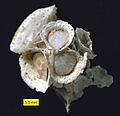| Hercosestria Temporal range: | |
|---|---|
 | |
| Hercosestria cribrosa (multiple individuals) | |
| Scientific classification | |
| Kingdom: | |
| Phylum: | |
| Class: | |
| Order: | |
| Family: | |
| Genus: | Hercosestria Cooper & Grant, 1969 |
| Species | |
| |
Hercosestria is an extinct genus of brachiopods from the Lower and Middle Permian. [1] They were important reef-forming organisms because of their conical shapes, attaching spines, and gregarious habits. [2] It is related to Richthofenia. [3] Species of the genus have been found in Texas (H. cribrosa and H. laevis) and Guatemala (H. notialis).

